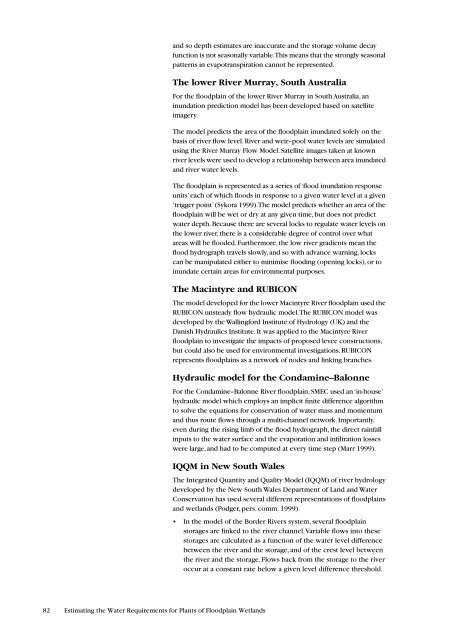Estimating the Water Requirements for Plants of Floodplain Wetlands
Estimating the Water Requirements for Plants of Floodplain Wetlands
Estimating the Water Requirements for Plants of Floodplain Wetlands
You also want an ePaper? Increase the reach of your titles
YUMPU automatically turns print PDFs into web optimized ePapers that Google loves.
and so depth estimates are inaccurate and <strong>the</strong> storage volume decayfunction is not seasonally variable. This means that <strong>the</strong> strongly seasonalpatterns in evapotranspiration cannot be represented.The lower River Murray, South AustraliaFor <strong>the</strong> floodplain <strong>of</strong> <strong>the</strong> lower River Murray in South Australia, aninundation prediction model has been developed based on satelliteimagery.The model predicts <strong>the</strong> area <strong>of</strong> <strong>the</strong> floodplain inundated solely on <strong>the</strong>basis <strong>of</strong> river flow level. River and weir–pool water levels are simulatedusing <strong>the</strong> River Murray Flow Model. Satellite images taken at knownriver levels were used to develop a relationship between area inundatedand river water levels.The floodplain is represented as a series <strong>of</strong> ‘flood inundation responseunits’ each <strong>of</strong> which floods in response to a given water level at a given‘trigger point’ (Sykora 1999). The model predicts whe<strong>the</strong>r an area <strong>of</strong> <strong>the</strong>floodplain will be wet or dry at any given time, but does not predictwater depth. Because <strong>the</strong>re are several locks to regulate water levels on<strong>the</strong> lower river, <strong>the</strong>re is a considerable degree <strong>of</strong> control over whatareas will be flooded. Fur<strong>the</strong>rmore, <strong>the</strong> low river gradients mean <strong>the</strong>flood hydrograph travels slowly, and so with advance warning, lockscan be manipulated ei<strong>the</strong>r to minimise flooding (opening locks), or toinundate certain areas <strong>for</strong> environmental purposes.The Macintyre and RUBICONThe model developed <strong>for</strong> <strong>the</strong> lower Macintyre River floodplain used <strong>the</strong>RUBICON unsteady flow hydraulic model. The RUBICON model wasdeveloped by <strong>the</strong> Walling<strong>for</strong>d Institute <strong>of</strong> Hydrology (UK) and <strong>the</strong>Danish Hydraulics Institute. It was applied to <strong>the</strong> Macintyre Riverfloodplain to investigate <strong>the</strong> impacts <strong>of</strong> proposed levee constructions,but could also be used <strong>for</strong> environmental investigations. RUBICONrepresents floodplains as a network <strong>of</strong> nodes and linking branches.Hydraulic model <strong>for</strong> <strong>the</strong> Condamine–BalonneFor <strong>the</strong> Condamine–Balonne River floodplain, SMEC used an ‘in-house’hydraulic model which employs an implicit finite difference algorithmto solve <strong>the</strong> equations <strong>for</strong> conservation <strong>of</strong> water mass and momentumand thus route flows through a multi-channel network. Importantly,even during <strong>the</strong> rising limb <strong>of</strong> <strong>the</strong> flood hydrograph, <strong>the</strong> direct rainfallinputs to <strong>the</strong> water surface and <strong>the</strong> evaporation and infiltration losseswere large, and had to be computed at every time step (Marr 1999).IQQM in New South WalesThe Integrated Quantity and Quality Model (IQQM) <strong>of</strong> river hydrologydeveloped by <strong>the</strong> New South Wales Department <strong>of</strong> Land and <strong>Water</strong>Conservation has used several different representations <strong>of</strong> floodplainsand wetlands (Podger, pers. comm. 1999).• In <strong>the</strong> model <strong>of</strong> <strong>the</strong> Border Rivers system, several floodplainstorages are linked to <strong>the</strong> river channel. Variable flows into <strong>the</strong>sestorages are calculated as a function <strong>of</strong> <strong>the</strong> water level differencebetween <strong>the</strong> river and <strong>the</strong> storage, and <strong>of</strong> <strong>the</strong> crest level between<strong>the</strong> river and <strong>the</strong> storage. Flows back from <strong>the</strong> storage to <strong>the</strong> riveroccur at a constant rate below a given level difference threshold.82 <strong>Estimating</strong> <strong>the</strong> <strong>Water</strong> <strong>Requirements</strong> <strong>for</strong> <strong>Plants</strong> <strong>of</strong> <strong>Floodplain</strong> <strong>Wetlands</strong>
















